October 2024
The global solar energy market size accounted for USD 137.02 billion in 2025 and is expected to be worth around USD 389.86 billion by 2034, registering a healthy CAGR of 12.32% between 2025 and 2034. The Asia Pacific solar energy market size is calculated at USD 49.33 billion in 2025 and is expected to grow at a CAGR of 12.47% during the forecast year. The market sizing and forecasts are revenue-based (USD Million/Billion), with 2024 as the base year.
The global solar energy market size was calculated at USD 121.99 billion in 2024 and is projected to surpass around USD 389.86 billion by 2034, expanding at a CAGR of 12.32% from 2025 to 2034. The demand for solar is escalated by the initiative to reduce the reliance on fossil fuels. This increases the demand for renewable energy sources which are a clean energy option in recent years.
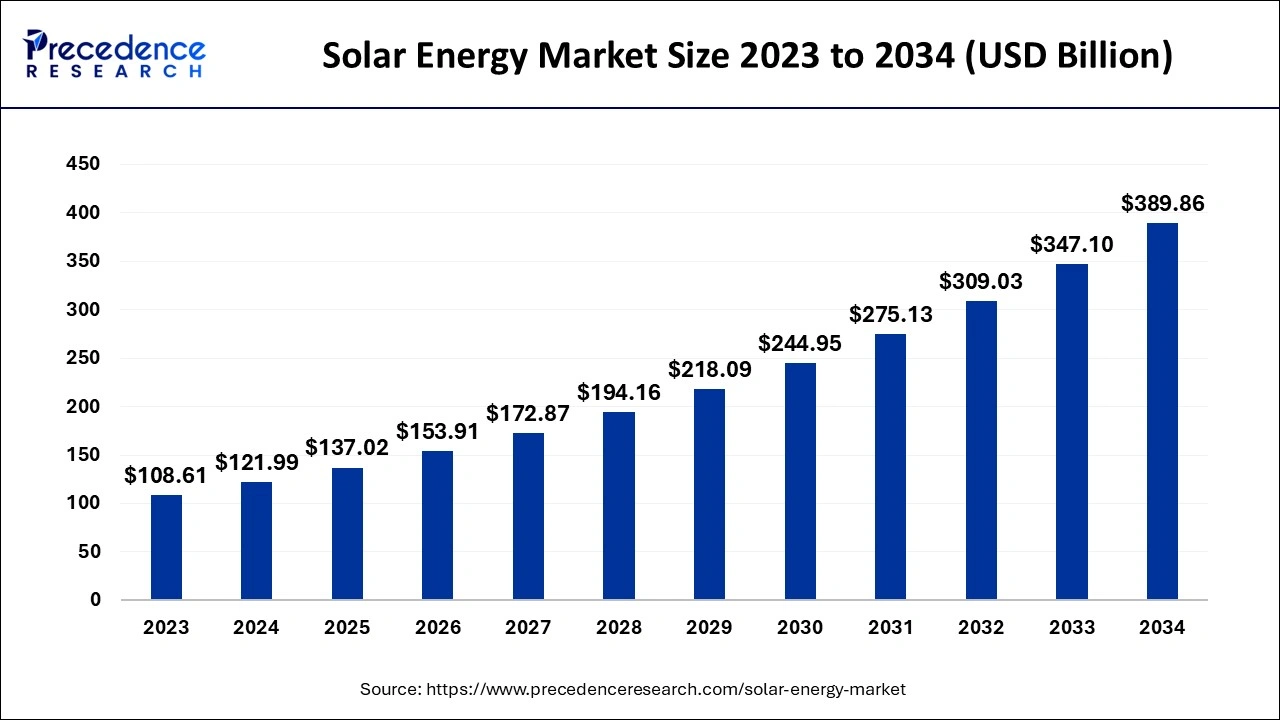
The emergence of technologies like Artificial Intelligence (AI) and Machine Learning (ML) are playing a crucial role in developing and enhancing energy production processes. AI algorithms are playing a crucial role in predicting the weather with the help of satellite imagery that can predict energy forecasting, contributing to the solar energy market. AI-based sensors are also helping to enhance the performance of the panels, which detect issues during the process that do not disturb the workflow. Additionally, these technologies can also help in energy optimization, which manages the need for energy, which can further be utilized when needed.
The Asia Pacific solar energy market size was exhibited at USD 43.92 billion in 2024 and is predicted to hit around USD 142.3 billion by 2034, growing at a CAGR of 12.47% from 2025 to 2034.
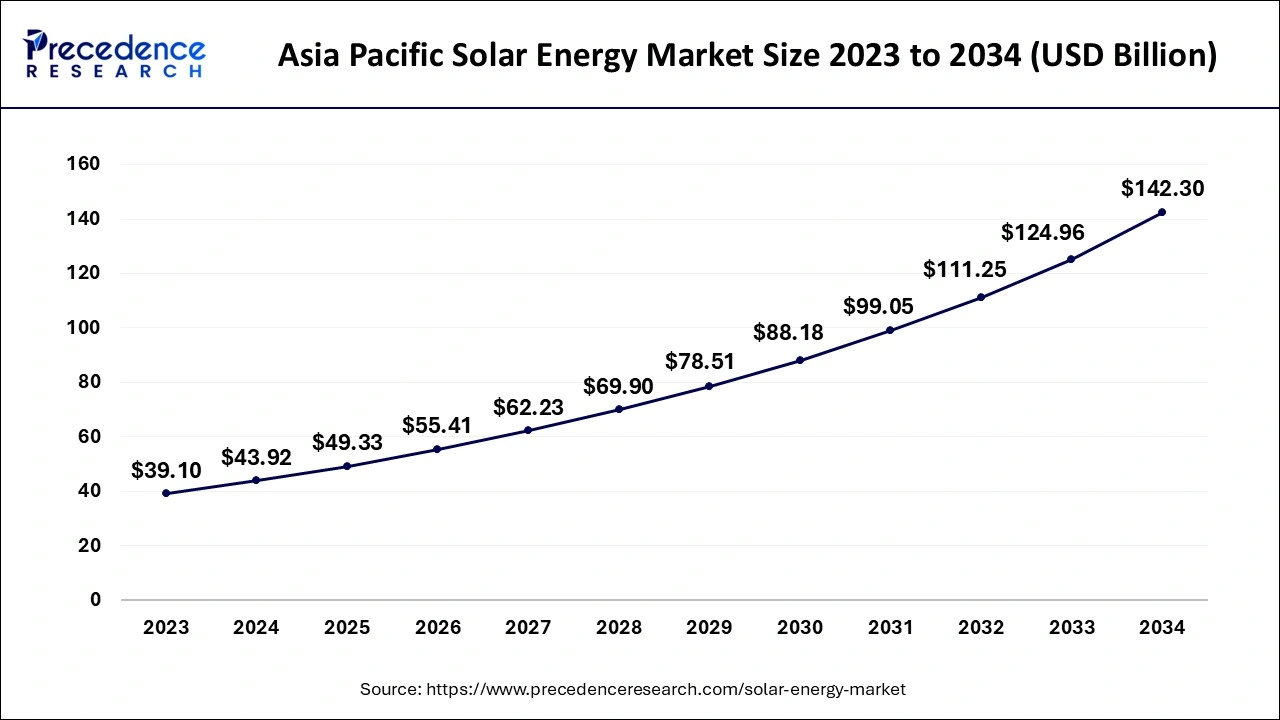
Asia Pacific dominated the global solar energy market in 2024. The dominance of the region is attributed to the rapid urbanization in countries like China, India, and Japan, which are witnessing higher electricity demand. India and China are the top two populated countries that are also focusing on the adoption of renewable plants, which will help in managing the power demand in the region. The region also has a wider industrial sector, which occupies the majority of the electricity demand, which creates multiple opportunities for solar adoption.
The Asia-Pacific region stands as a powerhouse in the global solar energy sector, driven by a myriad of compelling factors. Key among these are robust government initiatives aimed at enhancing renewable energy adoption, an escalating demand for energy security in the face of rising consumption, and a heightened emphasis on environmental sustainability, along with the urgent need to mitigate carbon emissions. This region is witnessing rapid demographic changes, including significant population growth and escalating urbanization, which in turn intensify the demand for cost-effective and dependable energy solutions. Various governments across the Asia-Pacific have enacted a spectrum of supportive policies that promote solar energy, featuring attractive incentives, comprehensive tax benefits, generous subsidies, and ambitious renewable energy targets that further encourage investment in solar technologies.
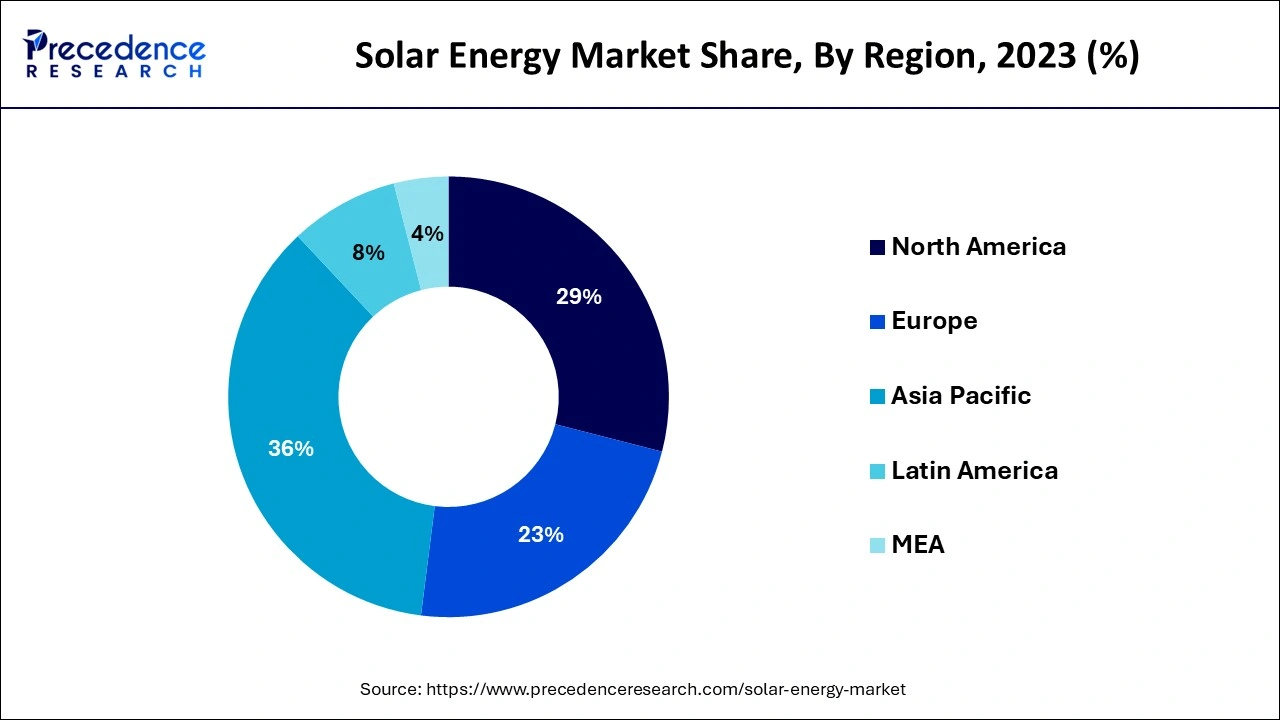
North America is anticipated to grow at the fastest CAGR in the solar energy market during the forecast period of 2025 to 2034. The region is growing efficiently due to the presence of countries like the United States and Canada, which are witnessing rapid investments in the industry. Additionally, the huge corporate industry base in the region is leading towards adopting renewable energy options that play a major role in the growth of the region.
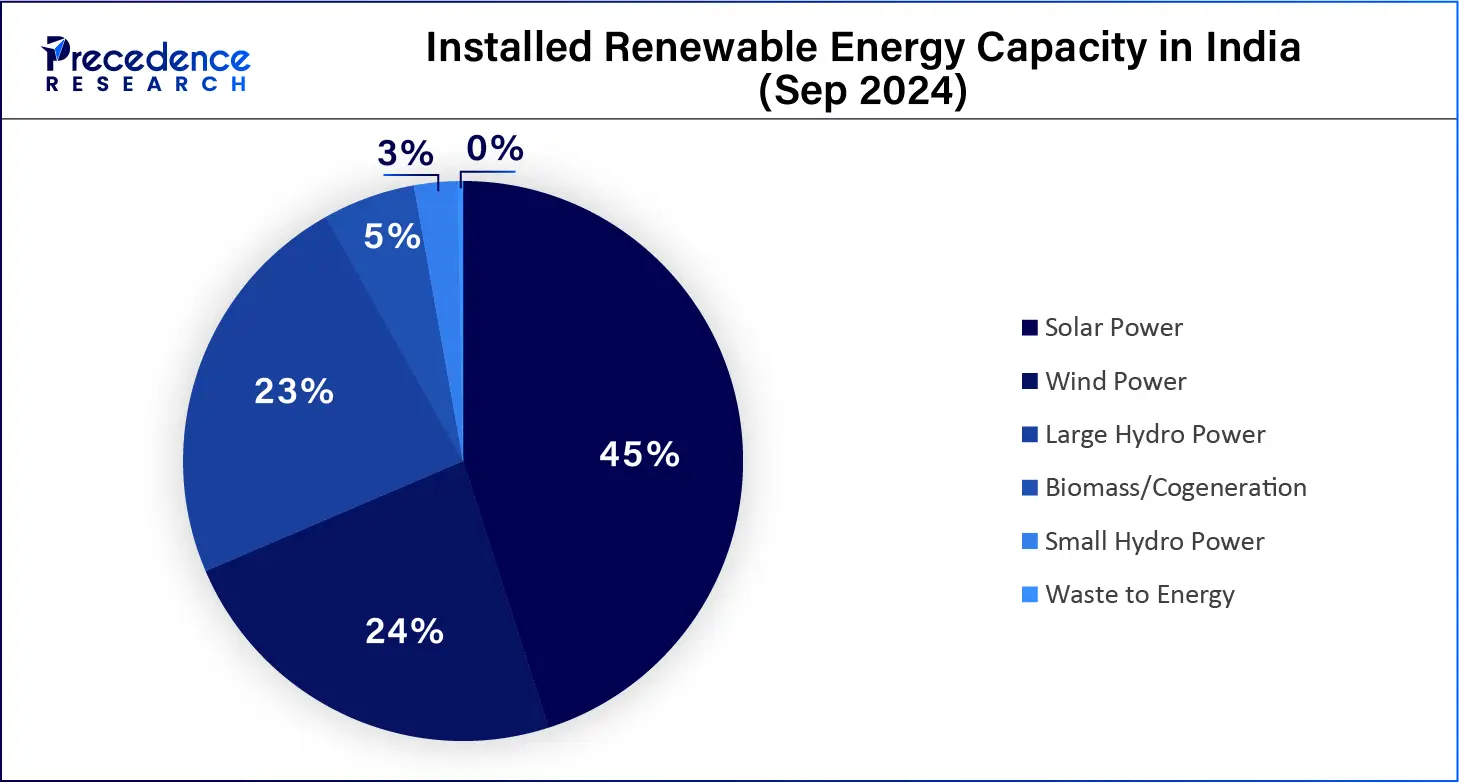
Europe is currently experiencing a remarkable surge in its solar energy market, spurred by a blend of strategic elements. This includes ambitious renewable energy targets set by various nations, proactive and supportive policy frameworks, a noticeable decline in solar module prices, and a growing inclination towards decentralized energy production methods. Noteworthy initiatives like the Energy Union and the Mediterranean Solar Plan are catalyzing innovation and facilitating large-scale deployment of solar power systems throughout the continent. In this context, the European Union and individual member states are rolling out policies designed to ease the adoption of solar energy, incorporating mechanisms such as feed-in tariffs, substantial subsidies, and streamlined permitting processes that expedite the installation of solar projects.
Solar energy refers to energy that is derived from the radiation of the sun, which can be implemented using various technologies like panels that can convert sunlight into electricity. Solar energy can be used in various applications where the sunlight can also be converted into heat. The solar energy market is gaining significant popularity due to the rising need for fossil fuel alternatives. Solar energy is considered to be sustainable, which can help reduce the environmental impact by being used for residential and commercial purposes. Adopting these plants can help in reducing the environmental impact and energy dependency on fossil fuels.
| Report Coverage | Details |
| Market Size by 2034 | USD 389.96 Billion |
| Market Size in 2024 | USD 121.99 Billion |
| Market Size in 2025 | USD 137.02 Billion |
| Market Growth Rate from 2025 to 2034 | CAGR of 12.32% |
| Largest Market | Asia Pacific |
| Base Year | 2024 |
| Forecast Period | 2025 to 2034 |
| Segments Covered | Technology, Solar Module, Application, End-user, and Regions |
| Regions Covered | North America, Europe, Asia-Pacific, Latin America and Middle East, & Africa |
Energy security
Energy management has become one of the major challenges, especially in underdeveloped and developing regions, which face challenges due to the higher costs and demand for fossil fuels. The solar energy market creates multiple offerings in these regions, which can help reduce energy dependency on fossil fuels. Developing solar-based energy sources creates multiple opportunities in the region where it is also generating employment in regions that can strengthen the country’s economy. Many governments are focusing on adopting lower solar plants that can help in managing the needs of the particular region.
Increasing demand for renewable energy
The increasing environmental awareness is leading to the changing preferences in energy generation. The use of fossil fuels is declining due to the rising climate change concerns, which is creating demand in the solar energy market. Organizations and companies are focusing on reducing the Greenhouse Gas (GHG) effect, which creates business opportunities in the renewable energy sector. The rising preference towards adopting renewable energy options is leading to technological advancements, such as the production of advanced solar panels and other power generation modules. The corporate sector is also focused on adopting these sustainable goals, which will help contribute to the growth of renewable energy adoption.
Higher initial investments
The rising environmental awareness has contributed to the adoption of solar energy but there are still some factors which are expected to hamper the market growth. Adopting these technologies often requires higher initial investments which can restrict its expansion in low-sized businesses and residential populations. This restricts the growth of the equipment market and can affect its costs due to the fluctuation in the market. The ROI in the solar energy market also takes a longer time, which cannot be affordable for small-sized income companies.
Rising energy prices
The limited availability of traditional energy is leading to a rapid increase in costs, which is making it unaffordable in many regions. The solar energy market presents several business opportunities that are attracting many consumers and businesses to adopt solar plants. Additionally, global initiatives towards adopting renewable energy are leading to long-term investments in the market, which will create employment in the upcoming years. The rising environmental awareness among the urban population is expected to drive the growth rate of solar panels in the region.
Government initiatives and policies
The increasing global initiatives towards adopting sustainable energy options have raised the opportunities that will boost the solar energy market growth in the upcoming years. Many governments are providing subsidies and tax incentives for installing solar panels in their homes, which will help in the adoption of renewable energy. For instance, the Indian government provides a subsidy to households for installing solar panels under the scheme named PM-Surya Ghar: Muft Bijli Yojana.
India is also focusing on the adoption of solar power grids where the government passed a scheme for solar power grids allocating 10,000 INR crore rupees. These policies will help the companies in the solar energy market to grow efficiently. Additionally, other nations are also focused on adopting these energy sources by investing in research and development.
The photovoltaic systems segment stood dominant in the global solar energy market in 2024. It is a system that converts sunlight into electricity by using solar cells. The dominance of the segment is attributed to its cost-effectiveness, which makes it preferable for residential and commercial use. PV systems are also growing efficiently due to their ease of installation compared to the others. The market is driven by the growth of these PVs due to their well-established consumer base from the past few decades. Many technological advancements are being made that focus on improving the efficiency of these systems.
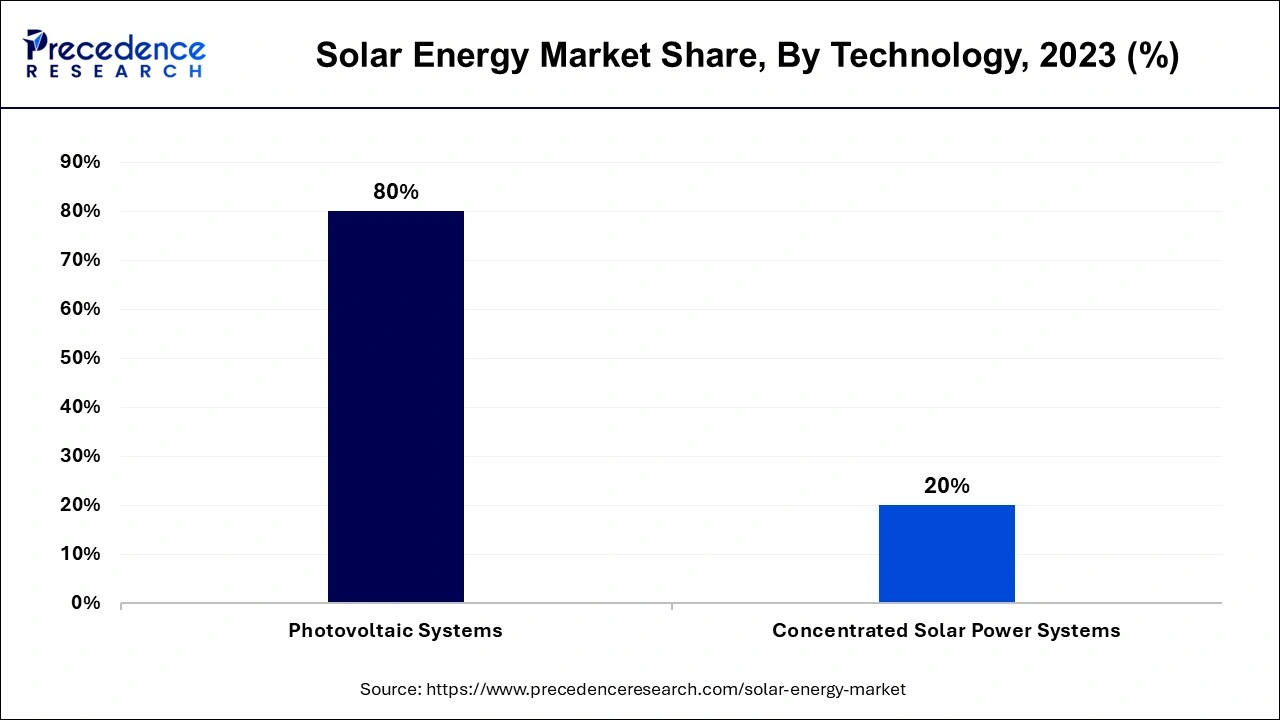
The concentrated solar power systems segment is anticipated to grow at the fastest CAGR in the solar energy market during the forecast period of 2024 to 2034. These systems use mirrors or lenses to concentrate the sunlight into a receiver. The growth of the market is attributed to the exceptional storage capacity of these systems, which helps manage electricity needs in complex weather conditions. The rising climate change is leading to the adoption of these systems, which are expected to fulfill consumer demand.
The polycrystalline segment held the largest share of the solar energy market in 2024. These modules are made of silicon crystals that are melted together, leading to the formation of solar cells. The dominance of the segment is attributed to the lower production costs of these solar modules, which can be used for multiple purposes in the market. This has led to its wider production due to its preferences in residential and commercial usage.
The monocrystalline segment is expected to register the fastest growth in the solar energy market during the forecast period of 2024 to 2034. These panels are produced by using a single silicon crystal. The market is driven by the enhanced energy efficiency of these panels, which maximizes energy output. These panels are gaining significant popularity in residential and commercial use as they produce more energy by consuming less space. Rapid technological advancements in developing passivated emitter and rear cell are expected to increase panel efficiency and reduce overall costs.
The industrial segment led the global solar energy market in 2024. The dominance of the segment is attributed to the rising energy needs in industrial companies. The market is helping companies to reduce overall expenses as it reduces energy bills. The industrial sector is also one of the major users of electricity, which reduces the availability of traditional energy. The availability of space in industrial setups is also higher, which makes it a perfect option for solar installations. Additionally, the rising government initiatives towards adopting renewable energies are also contributing to the adoption of solar panels in industrial setups.
The residential segment is anticipated to grow at the fastest CAGR in the market from 2024 to 2034. The rising disposable incomes in urban areas are one of the major growth factors that influence the adoption of these plants. The governments are also focusing on promoting the use of renewable energy sources through campaigns and subsidies that possess multiple opportunities in the residential solar energy market. Adopting solar panels in residential settings will also increase energy dependency, which will help reduce the use of fossil fuels.
The electricity generation segment dominated the global solar energy market in 2024. The dominance of the segment is attributed to the higher electricity need in the residential and commercial setting, which uses solar energy to produce massive amounts of electricity. The market is witnessing significant popularity due to the increasing urbanization in regions, which is leading to a higher demand for electricity generation.
By end-user, the lighting segment is projected to register significant growth in the solar energy market over the forecast period of 2025 to 2034. The growth of the market is attributed to the rising energy efficiency needed for the use of solar street lights and other lighting, which helps save electricity bills. Governments are adopting the use of lighting in infrastructure projects, which is expected to create many opportunities for rural and urban development projects.
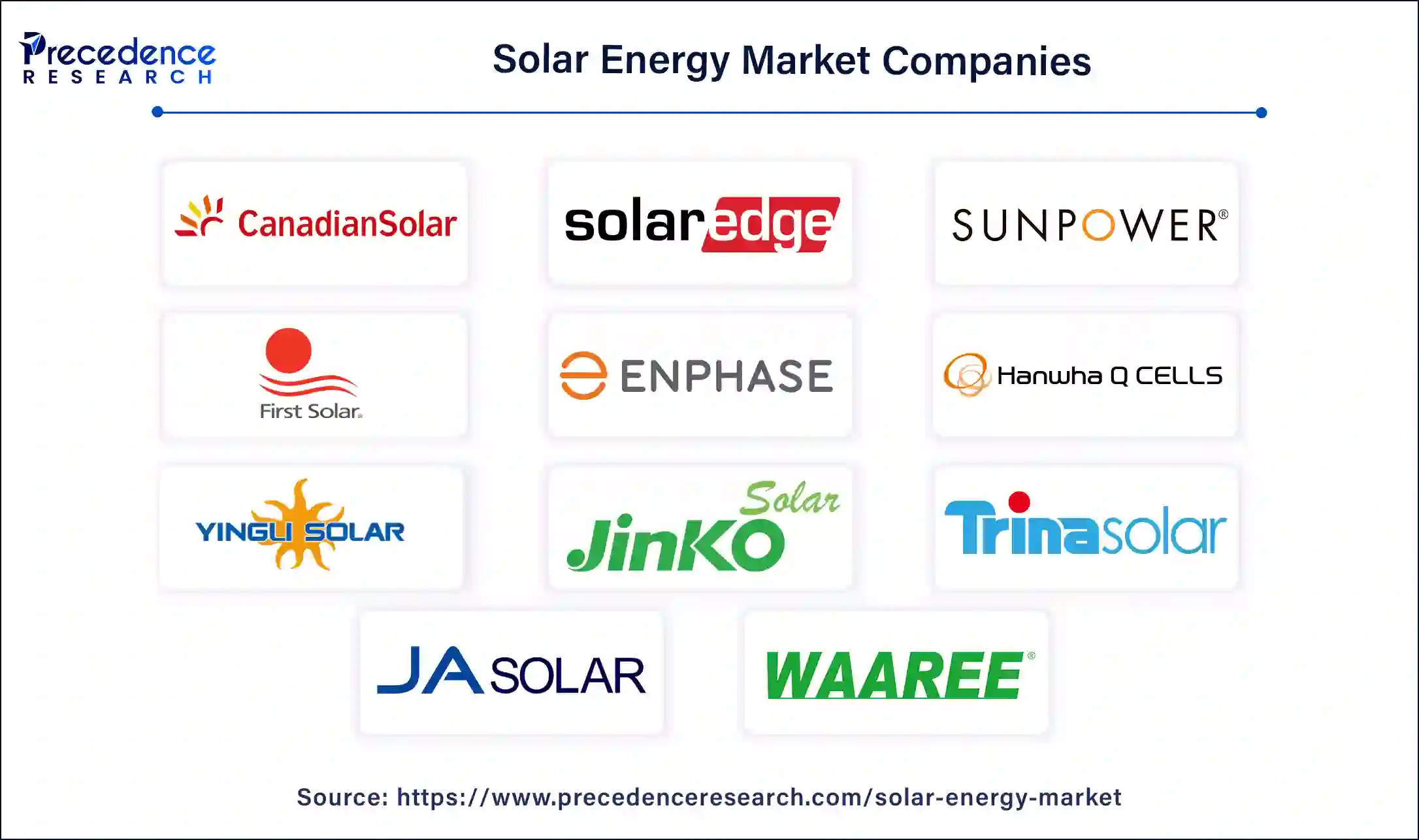
By Technology
By Solar Module
By Application
By End-user
By Geography
For inquiries regarding discounts, bulk purchases, or customization requests, please contact us at sales@precedenceresearch.com
No cookie-cutter, only authentic analysis – take the 1st step to become a Precedence Research client
October 2024
April 2025
June 2025
August 2024